 Mysteries
Mysteries  Mysteries
Mysteries  History
History 10 Surprising Stories About the Texas Rangers
 Humans
Humans 10 Philosophers Who Were Driven Mad by Their Own Theories
 Miscellaneous
Miscellaneous 10 Video-Game-Worthy Weapons and Armors from History
 Weird Stuff
Weird Stuff 10 Psychics Who Accurately Predicted Wartime Events
 The Arts
The Arts 10 Pieces of Art Inspired by a Broken Heart
 Health
Health 10 Science Fiction-Sounding New Medical Treatments
 History
History 10 Surprising Facts About the Father of Submarine Warfare
 Space
Space Ten Astonishing New Insights into Alien Worlds
 Weird Stuff
Weird Stuff 10 Bizarre Summer Solstice Rituals Still Practiced Today
 Mysteries
Mysteries Top 10 Haunting Facts About the Ghost Ship MV Alta
 History
History 10 Surprising Stories About the Texas Rangers
 Humans
Humans 10 Philosophers Who Were Driven Mad by Their Own Theories
Who's Behind Listverse?

Jamie Frater
Head Editor
Jamie founded Listverse due to an insatiable desire to share fascinating, obscure, and bizarre facts. He has been a guest speaker on numerous national radio and television stations and is a five time published author.
More About Us Miscellaneous
Miscellaneous 10 Video-Game-Worthy Weapons and Armors from History
 Weird Stuff
Weird Stuff 10 Psychics Who Accurately Predicted Wartime Events
 The Arts
The Arts 10 Pieces of Art Inspired by a Broken Heart
 Health
Health 10 Science Fiction-Sounding New Medical Treatments
 History
History 10 Surprising Facts About the Father of Submarine Warfare
 Space
Space Ten Astonishing New Insights into Alien Worlds
 Weird Stuff
Weird Stuff 10 Bizarre Summer Solstice Rituals Still Practiced Today
14 Stations of the Cross
Good Friday is the day traditionally set aside to remember the death of Jesus on the Cross. Good Friday is one of only two days in the year that Roman Catholics do not have Mass. Instead, on this day, most Catholic churches recite the Stations of the Cross (these are normally found an pictures around the inside walls of all churches). In the 12th century, Saint Francis of Assisi devised the list and started the tradition of reciting it as a type of devotional service. Structurally, Mel Gibson’s 2004 film, The Passion of the Christ, follows the stations. This is the complete list of the 14 stations, as Saint Francis defined them.
SEE ALSO: Top 10 Misconceptions About The Catholic Church
1 First Station
Jesus is condemned to death

The Sanhedrin, an exclusive council of elders, had Jesus arrested during Passover due to the fact that they felt threatened by his religious teachings. They put Jesus in front of Pontius Pilate to be tried for blasphemy. After Jesus was beaten and tortured, Pilate ordered him to punishment by death by crucifixion.
2
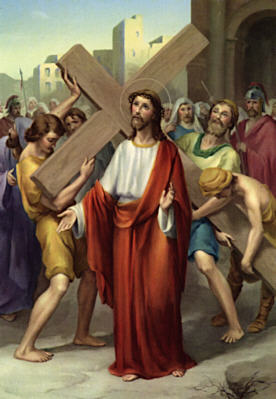
Jesus accepts his fate and is given a large wooden cross; he’s ordered to carry it to the location where he will be nailed to it and left to die. While the cross is heavy and difficult to move, Jesus never complains and begins his journey to Golgotha.
3
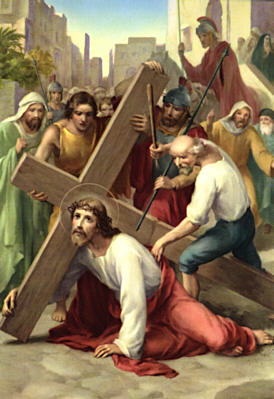
It was at this point that Jesus fell for the first time under the weight of the wooden cross. While there are no definitive dimensions or specs recorded of the cross, Catholic tradition says that Jesus fell three times under its weight.
SEE ALSO: 10 Disturbing Facts About The Church Of Almighty God
4

While carrying the cross, Jesus reunites with his mother, Mary. They look into each others eyes, both understanding the pain and heartache each are experiencing. After the brief encounter, Jesus continues carrying the cross to Mount Calvary.
Mel Gibson’s Passion of the Christ recreates this moment very well.
5

According to all three Synoptic Gospels, Simon initially just intended to observe Jesus carrying the cross to his crucifixion. Instead, Simon temporarily carried the cross after the Romans ordered him to help Jesus.
6
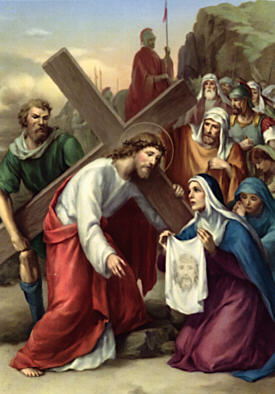
Veronica, a woman from Jerusalem and a disciple of Jesus, saw Jesus struggling while carrying his cross. Moved by his pain and sympathy, Veronica gave Jesus her veil in order to wipe away his perspiration and onlookers’ spit off his face. Jesus took the cloth, held it up to his face, and then returned to her. When Veronica looked at the fabric, an image of his face appeared upon it. This cloth is now known as the Veil of Veronica.
7

Although he had help from Simon and Veronica, Jesus continued to struggle carrying the cross to Golgotha, and fell again due to his wounds, abuse, and fatigue. Without saying anything, Jesus regained his footing and continued walking.
SEE ALSO: 10 Weird Facts About The Early Church
8
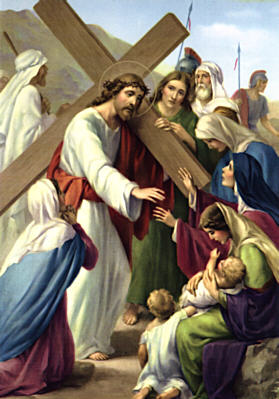
While many fought against him, Jesus had disciples who believed and trusted him. Some of those people were the women of Jerusalem who came to comfort and thank him during his trek to Mount Calvary. During this encounter, Jesus told them not to weep for him, but for the future of themselves and their children.
9
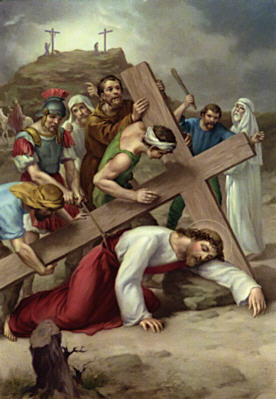
Not long after Jesus met the women of Jerusalem, he fell under the weight of his cross; this last fall was the worst. As Jesus struggled underneath the massive cross, his executioners demanded that he get up and continue. Roman soldiers eventually got him back up on his feet and forced to continue walking towards his imminent death.
10

Upon reaching Mount Calvary, soldiers removed Jesus’ clothes, leaving him naked, vulnerable, and humiliated. At this time, Jesus was beaten again, reopening old wounds on his back. At a certain point, onlookers stare at Jesus, as his eyes turn towards heaven.
11
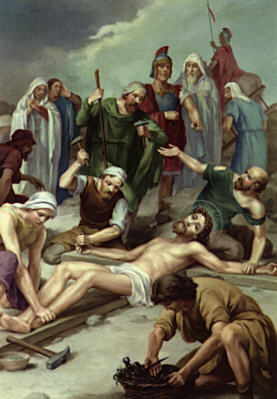
Jesus was nailed to his cross and placed between two thieves who were nailed to their own crosses for their crimes. Scholars argue whether three or four nails were used to fasten Jesus to his cross, but as it was lifted up, the weight of his body hung on those nails, increasing pain and blood loss.
12

After dying on the cross, according to the Gospel of John, a soldier stabbed Jesus in the rib cage with a spear to ensure that he was dead; blood and water gushed from the wound. Later, these soldiers divided his garments amongst themselves, including his seamless robe, also known as the Holy Tunic, the Honorable Robe, and Chiton of the Lord.
13

The lifeless body of Jesus is held by his mother, Mary at the base of his cross. A rich man known as Joseph of Arimathea, then appeared on the scene who deemed himself responsible for the burial of Jesus. Joseph offered an empty, man-made tomb in the garden of his house nearby to place the body of Jesus to rest.
14

The burial of Jesus took place in Joseph of Arimathea’s vacant tomb, as planned. Joseph wrapped the body of Jesus in linen, placed the body in his tomb, rolled a stone in front of its opening and left. The placement of the large stone over the tomb’s entrance is recognized the final sign of the permanence of death.
Of course, some people believe in a Fifteenth Station which represents the Resurrection of the Lord. Traditionally, there are only Fourteen Stations, but that number has always varied slightly throughout history and still does today.
SEE ALSO: Top 10 Shameful Moments in Catholic History
